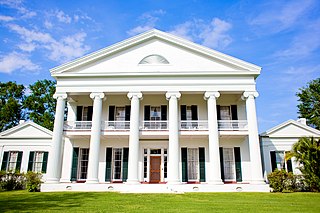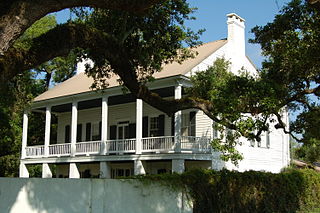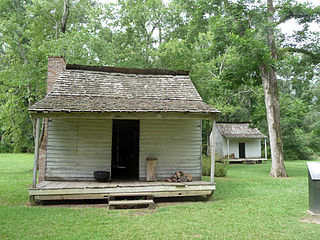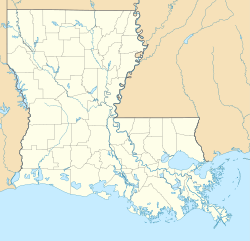
Port Allen is a city in, and the parish seat of, West Baton Rouge Parish, Louisiana, United States. Located on the west bank of the Mississippi River, it is bordered by Interstate 10 and US Highway 190. The population was 4,939 in 2020. It is part of the Baton Rouge metropolitan statistical area.

Riverlake is a plantation and an antebellum mansion, located on the west bank of the False River in Pointe Coupee Parish, Louisiana, about 8 miles (13 km) south of New Roads, Louisiana.

Laura Plantation is a restored historic Louisiana Creole plantation on the west bank of the Mississippi River in Vacherie, Louisiana. Formerly known as Duparc Plantation, it is significant for its early 19th-century Créole-style raised big house and several surviving outbuildings, including two slave cabins. It is one of only 15 plantation complexes in Louisiana with this many complete structures. Due to its historical importance, the plantation is on the National Register of Historic Places. The site, in St. James Parish, Louisiana, is also included on the Louisiana African American Heritage Trail.

Madewood Plantation House, also known as Madewood, is a former sugarcane plantation house on Bayou Lafourche, near Napoleonville, Louisiana. It is located approximately two miles east of Napoleonville on Louisiana Highway 308. A National Historic Landmark, the 1846 house is architecturally significant as the first major work of Henry Howard, and as one of the finest Greek Revival plantation houses in the American South.

The Magnolia Mound Plantation House is a French Creole house constructed in 1791 near the Mississippi River in Baton Rouge, Louisiana. Many period documents refer to the plantation as Mount Magnolia. The house and several original outbuildings on the grounds of Magnolia Mound Plantation are examples of the vernacular architectural influences of early settlers from France and the West Indies. The complex is owned by the city of Baton Rouge and maintained by its Recreation Commission (BREC). It is located approximately one mile south of downtown.

Woodland Plantation, in West Pointe à la Hache, Louisiana, is a historic building and a former plantation house. It is located at 21997 Louisiana Highway 23 in West Pointe à la Hache, in Plaquemines Parish, Louisiana. This sugar plantation was once worked by enslaved people. It has been listed on the National Register of Historic Places since June 18, 1998.

Oakland Plantation, originally known as the Jean Pierre Emmanuel Prud'homme Plantation, and also known as Bermuda, is a historic plantation in an unincorporated area of Natchitoches Parish, Louisiana. Founded as a forced-labor farm worked by enslaved Black people for White owners, it is one of the nation's best and most intact examples of a French Creole cotton plantation complex. The Oakland Plantation is now owned by the National Park Service as part of the Cane River Creole National Historical Park.

Magnolia Plantation is a former cotton plantation in Natchitoches Parish, Louisiana. The site was declared a National Historic Landmark in 2001, significant as one of the most intact 19th-century plantation complexes in the nation, as it is complete with a suite of slave cabins and numerous outbuildings and period technology. Included in the Cane River Creole National Historical Park, Magnolia Plantation is also a destination on the Louisiana African American Heritage Trail. It is one of two plantations in the park; the other is Oakland Plantation.

Melrose Plantation, also known as Yucca Plantation, is a National Historic Landmark located in the unincorporated community of Melrose in Natchitoches Parish in north central Louisiana. This is one of the largest plantations in the United States built by and for free people of color. The land was granted to Louis Metoyer, who had the "Big House" built beginning about 1832. He was a son of Marie Thérèse Coincoin, a former slave who became a wealthy businesswoman in the area, and Claude Thomas Pierre Métoyer. The house was completed in 1833 after Louis' death by his son Jean Baptiste Louis Metoyer. The Metoyers were free people of color for four generations before the American Civil War. The Métoyer family was derived from Marie, a former slave, and Claude, a Spanish military gentleman who bought and married Marie. They had many children but they were also one of the largest plantations and owned slaves themselves.

Tally-Ho Plantation House, is a historic mansion located along River Road in Bayou Goula, Louisiana.

Ashland Plantation, also known as the Belle Helene or Ashland-Belle Helene Plantation, is a historic building, built in 1841, that was a plantation estate and home of Duncan Farrar Kenner. Located in Darrow, Louisiana, in Ascension Parish. The manor house is an example of antebellum Greek Revival architecture.

Kent Plantation House is the oldest standing structure in Central Louisiana. Listed since 1971 in the National Register of Historic Places, Kent House is located in Alexandria in Rapides Parish. The plantation house is a representation of southern plantation life between 1795 and 1855. The main structure was erected in 1800 with the labor of people enslaved by Pierre Baillio. The bousillage Creole house and restored period outbuildings are now a showcase for tourists.

Audubon State Historic Site is a state park property in West Feliciana Parish, Louisiana, between the towns of St. Francisville and Jackson. It is the location where noted ornithologist and artist John James Audubon spent the summer of 1821.

Crescent Plantation is located on Walnut Bayou, Madison Parish, Tallulah, Louisiana. It was originally built in 1832 but a main section was constructed in 1855. The plantation was the home of doctor D.M. and Elizabeth DeMoss Dancy from 1855 until after the Civil War.

Rienzi Plantation House is a historic mansion located at 215 East Bayou Road in Thibodaux, Louisiana.

Frogmore Plantation is an historic, privately owned cotton plantation complex, located near Ferriday in Concordia Parish, Louisiana. Since 1997, Frogmore Plantation is a working farm, tourist attraction featuring many structures, and educational center. Buildings on the site include a cotton gin, and a plantation manor house named Gillespie. Formerly this plantation relied on enslaved African American labor.
The Acadia Plantation was a historic plantation house in Thibodaux, Louisiana, U.S.. It was the plantation of James Bowie, Rezin P. Bowie, and Stephen Bowie. James "Jim" Bowie, served in the Battle of the Alamo. It was listed on the National Register of Historic Places on May 29, 1987. It was demolished in 2010.

Allendale Plantation, also known as the Allendale Plantation Historic District, is a historic site and complex of buildings that was once a former sugar plantation founded c. 1855 and worked by enslaved African Americans. It is located in Port Allen, West Baton Rouge Parish, Louisiana.




















